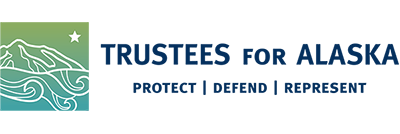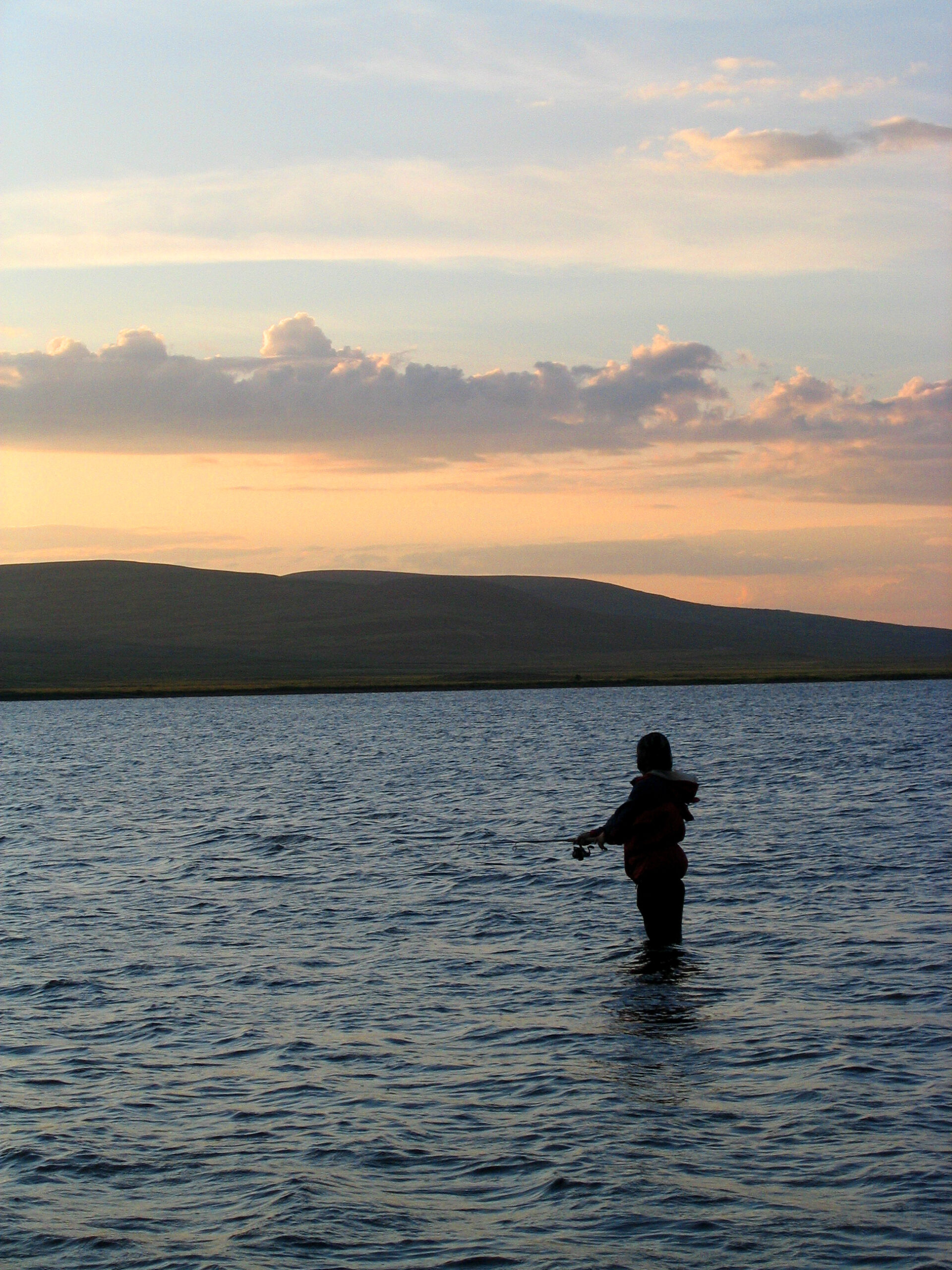
What does the Clean Water Act do, and how do we safeguard it during a deregulation dumpster fire?
By Dawnell Smith
A few summers ago, I paddled with friends through the silvery mist of Glacier Bay National Park in Southeast Alaska. The sky and ocean seamlessly transitioned within and between each other as air and rain, mist and oxygen, moving inside and through us, too.
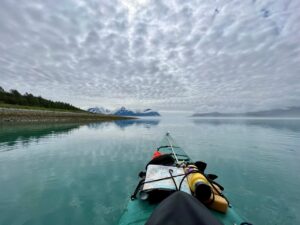
Dawnell kayaking in Glacier Bay on Solstice, 2023. Photo by Dawnell Smith.
The magic of flat light flushing through absolute presence revealed all parts as one and water as life.
From our kayaks, we clung to rocks while capturing water from small streams falling from mountain sides.
We drank it, we traveled on it, we witnessed its seamless flow from mist to spray to surge to tide to stillness embellished by inhabitants—the puffins, plovers, and scaups; the sea lions, sea otters and humpback whales; the wolves, bears and mountain goats; hunks of glacier ice transformed into rafts for seals.
What would make someone choose to ignore the ancient understanding and hard-fought agreements between human beings to protect water?
In the name of “you name it”
Convenience and comfort can make it hard to remember that water gives life. Though our watery home looks vast and deep and infinite, we do great harm when we forsake it in the name of sprawl and extraction, ease and greed.
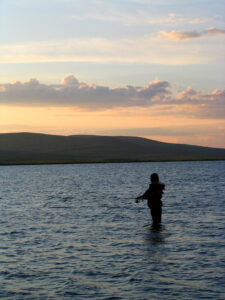
Fishing at sunset on Frying Pan Lake. Photo by Erin McKittrick.
The oil and gas industry, mining corporations, and even small private interest groups often see water only as a “local resource” to use when industrializing a place, or as a tool to extract, or as a holding pit for toxic waste.
A wholesale effort to eviscerate the Clean Water Act has taken hold over decades, with sound bites from political flaks that deride the so-called “puddles” that get in the way of an extraction project permit. These folks know but don’t mention how industrial pollutants like oil spills kill entire webs of life and impact people’s health, and not that long ago, those spills caught fire on city rivers for everyone to see. Those trying to gut the law protecting clean water know that people get mad when industry trashes and pollutes the waterways where folks get their drinking water, where they swim and fish, where they make a living and play.
People care about water and always have. Congress passed the landmark Clean Water Act in 1972 to protect waterways from the smallest streams to the biggest rivers to ocean coastlines precisely because people saw how industry had dumped toxins into water, made people sick, devastated fish and animals, and let rivers burn.
We might not see burning rivers in Pennsylvania these days, but water is under threat every day. A recent spill at the Red Dog Mine in Alaska makes it especially real for people who fish and live downstream. Red Dog calls it “process water” and the headline described it as “treated water,” but those vague terms evade the fact that Red Dog’s wastewater contains lead, zinc and other contaminants.
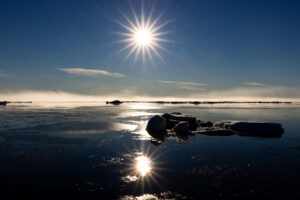
The sun at midnight in early July reflects on the Chukchi Sea. Photo by Lisa Hupp/USFWS.
A small spill from a mine with permits can devastate fish, animals, and people. Imagine what “no oversight” means—not only will toxins seep into water essential for our lives, but most people won’t know about it. And that’s the point. It took burning rivers in front of people’s eyes to change that back in the 70s, and shouldn’t we have learned from that?
Safeguarding water means setting and enforcing standards that prevent or at least put in place stringent controls on the discharge of pollution into waterways before they go up in flames.
An effective law under fire
The Clean Water Act has kept billions of pounds of pollution from waterways, with demonstrable benefits to drinking water, public health, animals, many food sources, and all the ways we use and relate to water.
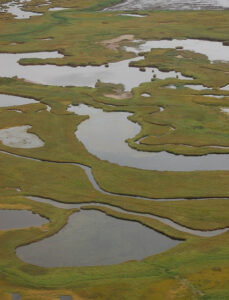
Izembek wetlands from above. Photo by Kristine Sowl.
At its basic level, the act requires states to set water quality standards to protect human use like swimming, fishing, and drinking, and to require permits to control pollution discharges from exceeding those standards. The act also contains other provisions to control the discharge of dredge and fill material into wetlands, which are the environmental filters that help protect healthy ecosystems. The term “Waters of the United States” establishes what water bodies fall under federal protection under the Clean Water Act, and historically the definition of that term has been broad.
Sure, plenty of wetlands and rivers continue to suffer from industrial pollution, sewer overflows, and much more, but the Clean Water Act provides us with a means to do something about it.
But those who get rich at the expense of clean water have steadily chipped away at our collective safeguards, using the courts and politics to undo what citizens fought for decades ago.
Going through the legal ringer
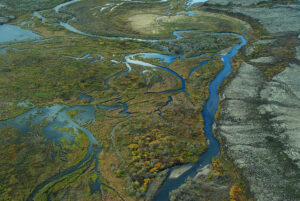
Aerial view of braided-wetlands and tundra on Upper Talarik Creek. Photo courtesy of US EPA.
A 2023 U.S. Supreme Court ruling in Sackett v. Environmental Protection Agency determined that over half of all wetlands are not protected by law. In other words, against all common sense about how water works, the court decided that the lack of a “continuous surface connection” to major lakes and rivers meant that the wetlands in question were not subject to the Clean Water Act. This was a significant narrowing of the definition of “Waters of the United States.”
The on-the-ground result? A permit wasn’t needed in that case to dump pollutants or destroy wetlands. Worst yet, a recent Environmental Protection Agency memo emphasized that the agency would enforce that ruling and further diminish the waters covered by the Clean Water Act.
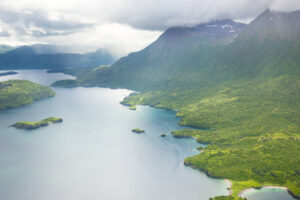
Coastline along Kodiak National Wildlife Refuge. Photo by Lisa Hupp, USFWS.
A more recent Supreme Court ruling in March says the Environmental Protection Agency does not have the authority to compel polluters to comply with water quality standards as a condition of their permits. Specifically, the decision allows the city of San Francisco to continue dumping raw sewage into the Pacific Ocean. More broadly, this ruling comes as another blow to the Clean Water Act, undermining pollution standards and making it easy for polluters to dump and run.
The folks dismantling the highly successful Clean Water Act that helps safeguard the water we sip and clean with, the fish we catch, the rivers we run, and so much more regurgitate the tired tall tale that easing and eliminating regulations will help “everyday people,” but in fact, the push for gutting the law will only enrich big business and big projects while leaving the rest of us with the toxic dregs.
This is the third in our “laws under fire” series. You can find previous articles below:


